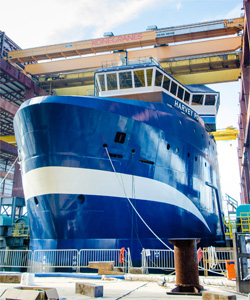The maritime industry in the United States has been somewhat slow to embrace liquefied natural gas (LNG) as a fuel for vessels. Harvey Gulf International Marine, by contrast, began moving ahead rapidly as soon as its leadership became convinced of the benefits.
In fact, it took just a few days for the company to move from serious consideration of LNG to a commitment to build a fleet of LNG-powered offshore supply vessels, according to Chad J. Verret, Harvey Gulf’s executive vice president, Alaska and LNG operations.
In early 2011, Verret read an article in a trade publication about a new LNG-fueled Norwegian platform support vessel that had just been delivered. What he saw was a vessel that would be highly efficient and environmentally friendly. Spurred by that article, Verret and Mike Carroll, Harvey Gulf’s senior vice president, new construction/chief naval architect, spent an intense weekend working on a design.
Starting with the layout of an existing Harvey Gulf OSV, Harvey Champion, the two men worked out the basic design for what is the first LNG-fueled commercial vessel to enter service in North America.
“Over the course of a long weekend we took the current design and adapted it,” Verret said.
“We had a full general arrangement concept by Monday,” Carroll said.
On that Monday, they presented their proposal to Shane Guidry, Harvey Gulf’s chairman and chief executive officer. He approved it on that day and Harvey Gulf was off and running.
Harvey Energy, the first of six 302-foot dual-fuel vessels being built at Gulf Coast Shipyard Group’s facility in Gulfport, Miss., was scheduled for delivery in late October 2014. The five others are scheduled for delivery at four-month intervals.
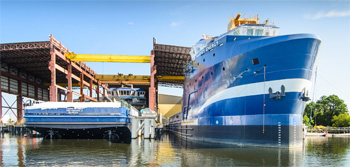 |
|
The second boat in the series, Harvey Power, can be seen at left. |
|
Brian Gauvin |
Verret and Carroll are proud of the pioneering role Harvey Gulf has assumed. “Harvey Gulf is the first, not the second, to adopt dual fuel,” Carroll said. “We’re absolutely first. This is the right technology.”
Being a pioneer can be risky, but Harvey Gulf believes the case for LNG is overwhelming, both in environmental and in economic terms. And the economic and environmental advantages are closely intertwined.
The economic success of any OSV is dependent on the oil companies that charter them to service their offshore rigs. Every federal oil lease granted to an oil company operating in the Gulf of Mexico now requires the use of the best available technology for the capture of particulate emissions by the rig and support vessels operating within a 25-mile radius.
As a dual-fuel vessel, Harvey Energy will operate on a fuel mix of 99 percent natural gas and 1 percent diesel oil. If LNG were unavailable, it could operate on diesel alone. Because combustion of natural gas produces no particulate matter, Harvey Energy and its sister vessels will emit almost no particulates.
Harvey Gulf thinks this attribute will make its vessels the support boats of choice for oil companies drilling and producing in the Gulf of Mexico.
As Verret and Carroll were conceptualizing these LNG boats, environmental appeal to the oil companies was a major influence on their thinking. “Mike and I were absolutely focused on that,” Verret said. Conventional diesels, he suggested, may have a hard time meeting expectations in such a regulatory environment. “We were convinced this was the best way forward to meet this requirement.”
Other pending environmental requirements may also give LNG-fueled vessels an advantage over conventional diesels. On Jan. 1, 2016, new Tier 4 emission control regulations from the Environmental Protection Agency will take effect for many new vessels. To meet the more stringent standards for sulfur oxide, nitrogen oxide and particulates, most engine makers are planning to add urea injection features to their exhaust systems.
When operating on LNG, Harvey Energy will meet the Tier 4 requirements.
 |
“Why wouldn’t you take the significant reductions (of LNG) to meet the EPA requirements without urea?” Verret said, noting that urea treatment systems will mean additional maintenance and operating costs.
Then there is the compelling fact that LNG is currently much cheaper than diesel. While oil and gas prices are frequently volatile, North American natural gas production has been growing rapidly and no end to the boom is in sight. So the evidence suggests that LNG will maintain a price advantage for some time to come.
“At the end of the day, LNG is cheaper,” Verret said.
At current prices, LNG is approaching half the cost of diesel fuel per unit of energy, depending on location, frequency and size of delivery, according to John F. Hatley, Americas vice president, ship power, with Wartsila North America.
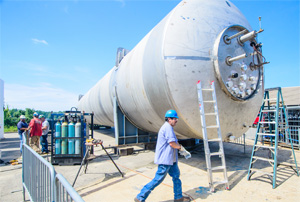 |
|
Workers prepare an LNG tank for installation at Gulf Coast Shipyard Group. Each of the six boats in the Harvey Energy class for Harvey Gulf will have one of the cylinders, which are about 100 feet long. |
|
Brian Gauvin |
Wartsila is providing Harvey Gulf with the entire diesel-electric propulsion system as well as its associated fuel systems, including the LNG tank and bunker system.
“We provided a complete LNG kit,” Hatley said.
The main genset engines are Wartsila 6L34DF dual-fuel diesels. Three of them produce a total of 10,100 bhp. They will power two azimuthing stern drives: Wartsila LIPS FS300 WS/WN units producing 3,620 bhp each. The vessel has two bow thrusters: LIPS FT225 M-D units producing 1,717 bhp each.
In providing the LNG kit to Harvey Gulf, Wartsila is supplying all the components of the propulsion system and associated LNG fuel system, including alarms, controls and automation. The responsibility for integrating the systems and ensuring that they all work together properly rests with Wartsila.
“This reduces the risk for the owner and the shipyard,” Hatley said.
Hatley acknowledged that adopting a new technology like LNG poses certain risks, all of which he maintains Wartsila has addressed. The goal, he explained, is to be on “the leading edge” rather than on “the bleeding edge.”
In a sense, the technology is not really new. Hatley pointed out that Wartsila has been building natural gas engines since the late 1980s. The first gas engines were large 50-cm-bore engines for specialized LNG tankers that burn the boil-off vapors from their cargo. Next Wartsila brought out 32-cm-bore engines whose first marine applications were in support vessels built for Norway’s North Sea oil and gas operations.
A decade ago, Wartsila brought out a 34-cm-bore engine that is the basis for the dual-fuel genset that will power Harvey Energy. Skandi Gamma, the 311-foot Norwegian platform supply vessel that caught the eye of Harvey Gulf in 2011, is equipped with a Wartsila 34-cm-bore engine.
So while Harvey Gulf may be pioneering the technology in North America, it will benefit from the experience Wartsila has gained in Europe with vessels of similar size and purpose. “We have lots and lots of experience,” Hatley said.
Wartsila may have lots of experience with LNG propulsion, but the Harvey Gulf personnel who will operate the new vessels do not. So, training of crews will be of paramount importance.
“You have to have a pool of educated mariners who can operate the equipment safely,” Hatley said.
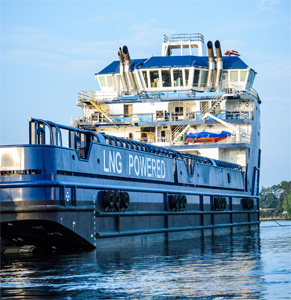 |
|
Harvey Energy’s propulsion source is clearly displayed on the vessel. |
|
Brian Gauvin |
Wartsila has addressed the issue by creating a system of schools around the world to train people in the operation of its natural gas engines. Called the Wartsila Land & Sea Academy, the network includes five schools, including one in Fort Lauderdale, Fla., that provide training to operators of LNG engines.
“It’s very much like a community college,” Hatley said, noting that each school represents “a center of expertise on LNG.”
Harvey Gulf is taking advantage of the training offered by Wartsila in Fort Lauderdale. Harvey Gulf mariners will take LNG courses on engine operation, propulsion, electronic alarm systems and fuel delivery and storage.
Harvey Gulf also partnered with the Maritime Simulation Institute in Middletown, R.I., to develop an LNG bunkering safety course. The first sessions for Harvey Gulf employees were held in July 2014. The courses are open to employees of other companies as well.
Developing a boat that runs primarily on LNG creates substantial design challenges. One of the greatest is onboard storage. LNG contains less energy by volume than diesel oil. That means the tanks have to be significantly larger to give the boat the same range as a conventional diesel. And these bulky, highly insulated tanks can’t be tucked just anywhere in the hull.
Each of the LNG boats in the new class will have a single cylindrical tank located along the centerline under the cargo deck just aft of the house. At 100 feet, the tank (including cold box) will be about a third as long as the vessel.
A vessel like Harvey Energy earns its living by transporting materials needed by oil rigs, such as liquid mud, fuel, methanol, cement and drilling water. To make up for the extra space needed for LNG storage, Harvey Gulf is making the new boats 10 feet longer than the 292-foot Harvey Champion, which was the starting point for the LNG design.
“We had to arrange the LNG system so it did not diminish the capabilities of the vessels versus conventional diesels,” Carroll explained, in order to make the boats “functional and marketable.”
In a conventional boat, fuel tanks are placed low in the hull. Keeping the weight low enhances a vessel’s stability. Despite the location of the LNG fuel tank just under the cargo deck, Harvey Energy and its sisters will be stable boats, according to Carroll.
“These boats have a lot of reserve stability,” he said.
In addition to the lower energy content of LNG, another disincentive for using it has been availability of the fuel, or what might be called the “chicken and egg” problem. In the absence of a network of LNG fueling stations, operators may be reluctant to build LNG vessels. And in the absence of a fleet of LNG vessels, it is hard to justify building a network of fueling stations.
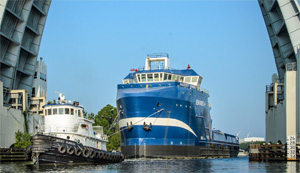 |
|
The tug Signet Puritan pulls the OSV through the Lorraine-Cowan Bridge on the Industrial Seaway in Mississippi. Harvey Energy was heading to the Port of Gulfport for finishing installations and sea trials. |
|
Brian Gauvin |
Harvey Gulf has solved the problem by building its own LNG fueling station to service its vessels and others that may follow the company’s lead. In February 2014, Harvey Gulf broke ground on the fueling station in Port Fourchon, La., where its new LNG boats will be based. The $25 million marine fueling project is the first of its kind in the United States, according to Harvey Gulf. The facility, consisting of two sites with 270,000 gallons of LNG storage each, was scheduled to become operational in November 2014.
Building a new vessel incorporating unfamiliar technologies also poses challenges for a shipyard. “It’s not something you throw at any yard. You have to be heavy in project management,” said William S. Smith III, vice president of Gulf Coast Shipyard Group.
One advantage Gulf Coast Shipyard has for a project as complicated as this is the amount of work that it can do indoors, protected from the weather. The yard boasts 10 acres of covered space. “You’re better able to manage the delivery time if you’re under cover,” Smith said.
Part of the risk inherent in building a new vessel type has been mitigated by the arrangement with Wartsila, which is responsible for procuring and integrating all of the fuel and engine components. “Wartsila is providing everything, from soup to nuts,” Smith said.
Some of the work is without precedent in the United States. “You can imagine the quality control … required for all that (LNG) piping,” he said.
Yet the biggest difficulty, according to Smith, was not so much the actual construction as coordinating the involvement of all the players in a project that in many ways was setting new standards as it proceeded.
“The biggest challenge with LNG is getting everybody — ABS, the Coast Guard, Harvey Gulf, Wartsila — on the same page,” he said.
Some aspects of the construction, of course, involved fairly conventional issues such as choice of the interior materials. But even here, the Harvey Gulf boats may be a bit special.
“Shane (Guidry) picked the interior decoration personally … fabrics, countertops, everything. It was pretty remarkable,” Smith said.
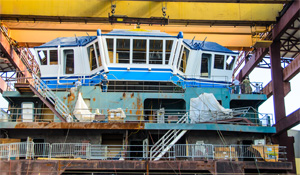 |
|
Workers at Gulf Coast Shipyard Group set the pilothouse on Harvey Power. Four additional LNG-powered OSVs will follow for Harvey Gulf International. |
|
Brian Gauvin |
Clearly, these will be trailblazing boats. The question remains how many other vessel operators will elect to follow this path. There is no doubt that the rest of the industry is watching very closely.
On this side of the Atlantic, Verret said, “this is probably the most talked-about project in three years.”
There are doubters that LNG will really prove to be the wave of the future. The Harvey Gulf boats, once they go into service, should demonstrate the benefits and the limitations of LNG-fueled vessels in the offshore oil and gas industry.
“The naysayers want to see the boat in service,” Carroll said. “I guarantee they are all paying attention to our project.”
If the new Harvey Gulf boats live up to expectations, they have the potential to exert a transformative effect on the industry. “We believe in LNG as a fuel,” Verret said. “We believe in this technology wholeheartedly.”
If his conviction is borne out by experience and the Harvey Gulf boats prove to be in demand by the rig operators, the rest of the offshore industry will have to take a hard look at following Harvey Gulf’s lead.
“It doesn’t take long for others to realize if we’re getting orders for these vessels,” Carroll said.

